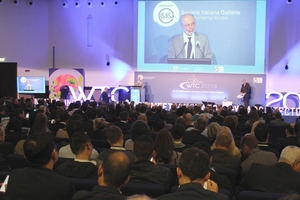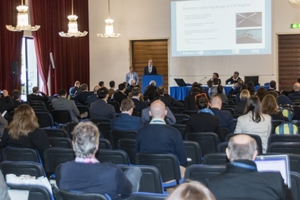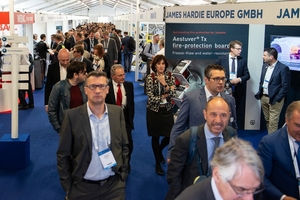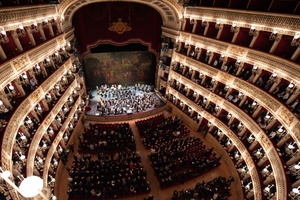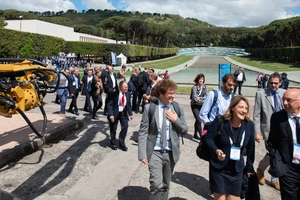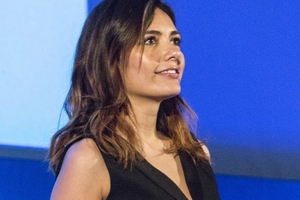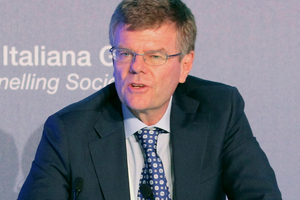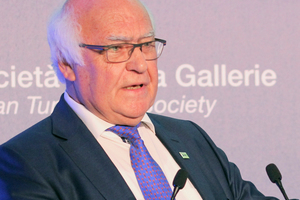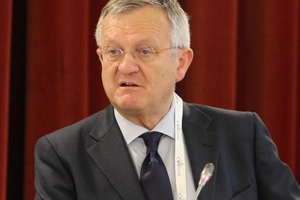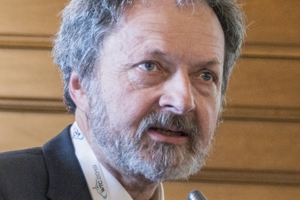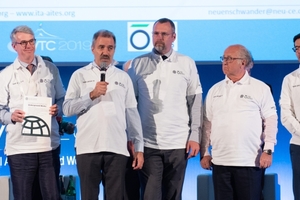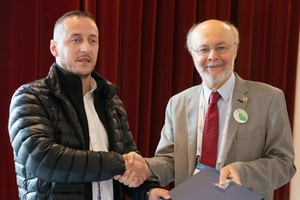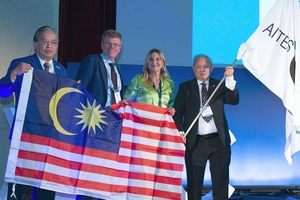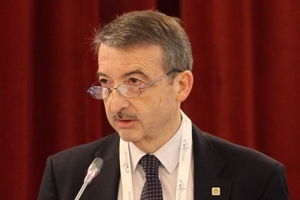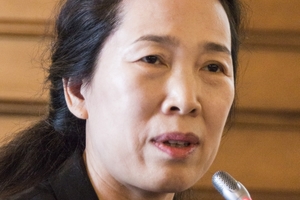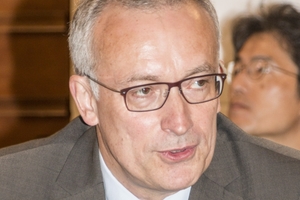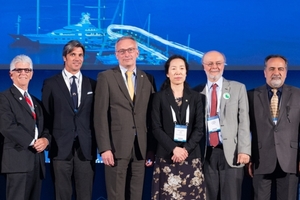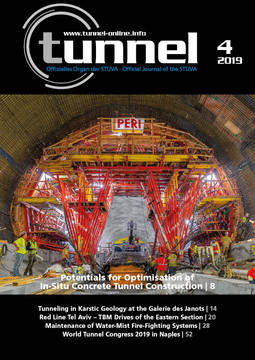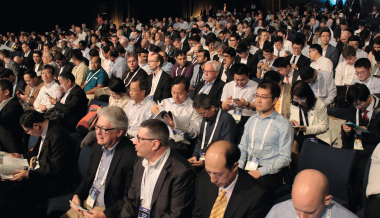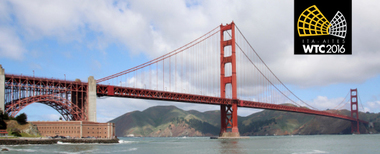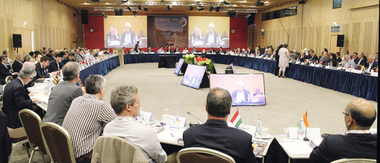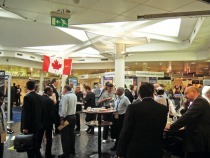ITA Annual Conference and World Tunnel Congress 2019 in Naples, Italy
Around 2000 participants from 73 countries gathered in Naples, Italy from May 3 to 9, 2019. The occasion was the 45th General Assembly of the ITA (International Tunnelling and Underground Space Association) in conjunction with the 2019 World Tunnel Congress (WTC).
The Tunnel Congress organised by the Italian Tunnelling Committee (Società Italiana Gallerie, SIG) in collaboration with the ITA was captioned “Tunnels and Underground Cities: Engineering and Innovation meet Archaeology, Architecture and Art”
(Fig. 1). 62 of the current 78 ITA member nations were present in Naples. At 79 % the proportion of countries represented was thus some 15 % higher than last year in Dubai (please see Infobox at the end of the article).
1 World Tunnel Congress 2019
The main congress programme was devoted to 11 groups of topics:
1. Archaeology, Architecture and Art in underground construction (ITACUS*)
2. Environment sustainability in underground construction
3. Geological and geotechnical knowledge and
requirements for project implementation
4. Ground improvement in underground constructions
5. Innovation in underground engineering, materials and equipment (ITA-TECH*)
6. Long and deep tunnels
7. Public communication and awareness
8. Risk management, contracts and financial aspects
9. Safety in underground construction (ITA-COSUF*)
10. Strategic use of underground space for resilient cities (ITACUS*)
11. Urban tunnels
(* Parts of these blocks of topics were staged and presented by the responsible committees)
The three committees ITA-COSUF, ITACUS and ITA-TECH each had their own block, which fitted seamlessly into the WTC programme. Thus, on the Tuesday afternoon, ITA-COSUF provided papers on safety in tunnel operation (Fig. 2). ITA-TECH dealt with “Soil Conditioning for EPB Tunnelling and Backfilling” at its session. And ITACUS tackled “Strategic Use of Underground Space for resilient Cities” following up on ongoing considerations relating to the future use of underground space in urban areas. In addition, ITACUS delved into topics pertaining to “Archaeology, Architecture and Art in underground Construction”. So-called Off-site events were also provided on these topics under the banner “AAA” (Archaeology, Architecture and Art). These were presented outside the congress premises and commanded an additional participation fee.
The 180 lectures of the main programme were presented in five parallel sessions; simultaneously more than 400 E-Poster presentations took place, in which the contributions were made accessible to interested parties through explanations taking the form of a brief presentation on a monitor. The long versions of the papers and poster presentations are published in the World Tunnel Congress’s digital proceedings.
Akin to previous years, Committee and Working Group sessions also took place alongside the “technical sessions”. Furthermore, on the Thursday after the congress various field trips to sites were available. At the accompanying trade exhibition around 200 companies presented their products and services over a total area of 2500 m² (Fig. 3). As a free cultural highlight, the Congress participants were able to attend an outstanding concert in the Teatro di San Carlo built back in 1737, where various overtures were performed (Fig. 4). Certainly, an unforgettable evening for the participants, which the organisers
of future WTCs are recommended to emulate.
Organisation
The various lecture rooms and the exhibition were so far apart in the rather dilapidated Mostra d`Oltremare fairgrounds that there was scarcely time to grab a coffee
during the shortish breaks owing to the lengthy distances that had to be covered (Fig. 5). In addition, long queues formed at the refreshments stands and the baristas had obvious difficulties providing the vistors with refreshments in time. In a similar fashion, the WiFi network was also unable to cope, mostly denying would-be users access. As a result, the special app devised for the WTC could not be used. This app was intended to assist participants to find the technical sessions, poster presentations, discussion and exhibition areas, which were scattered throughout the outer and inner premises as well as in tents.
As the organisation of the WTCs has often not been up to scratch in the past, last year the Executive Council established a Working Group. Its first step was to send a questionnaire to all member countries to find out how the selection process, organisation and format of the WTC could be improved. Based on the 18 responses that were received and an analysis of the WTCs held between 2011 and 2018, the WG provided a draft for an almost 40-page WTC planning guide, which was first passed on to the representatives of the member nations for scrutiny. It is intended to introduce the new rules at the 2020 General Assembly.
ITA Training Course
In previous years, a special ITA Training Course was held prior to the congress. Two such parallel courses were staged in Naples on May 3 and 4, 2019, which had been organised jointly by the Italian Tunnelling Committee, the Committee on Education and Training (ITACET) and the ITACET Foundation. These courses targeted young professionals and bore the titles “Tunnelling 4.0: Information Technology for the Design, Construction and Maintenance of Underground Works” and “Communication and Stakeholder Engagement in Tunnel Design, Construction and Operation”. Altogether, 75 participants attended the first course and 35 the second – stemming from 25 different countries. They took advantage of the opportunity during the two days to consolidate their knowledge of the topics mentioned above.
In the first course, internationally recognised experts with an academic and entrepreneurial background presented some 20 papers dealing with aspects of digitalisation for planning, construction, maintenance and refurbishment in tunnelling as well as increasing automation and the application of virtual reality for the maintenance of underground facilities. The second course underlined that communicating well with the public and affected interest groups can largely influence the success and acceptance of a project. The main objective was to provide information about existing and new techniques and approaches of communication to put across the value and benefits of underground infrastructures for society as a whole.
Opening
The opening event was held in two halls, linked up by video transmission, and hosted by two moderators (Fig. 6). The reason for this was that the alledged 2000 people taking part would not have fitted into a single hall, although there were many free places during the event itself. As a result, participants could only see half of the speakers via a video link, which failed to reproduce a fully synchronised version of the sound and picture.
Luigi De Magistris, mayor of Naples, Maurizio Gentile, director of Rete Ferroviaria Italiana and representative of the Ministry of Infrastructure and Transport, Andrea Pigorini, president of SIG (Fig. 7), as well as ITA President Tarcísio B. Celestino first of all welcomed the participants. During the first part of the event Pietro Salini, chairman of the board of the international construction company Salini Impregilo from Italy, presented an introductory paper in which he highlighted difficulties faced by the industry for instance, in recruiting trainees, the competitive situation or the distribution of risks in tunnelling. Then Alessandro Viscogliosi from Rome’s La Sapienza University for Architecture dealt with historic underground structures, which were built so to speak negatively in rock. The first block was rounded off by Guido Tonelli, CERN, with an extremely entertaining paper on “Tunnels for Science”. Subsequently, the ninth lecture held in memory of Sir Alan Muir-Wood was presented. In this “Muir-Wood Lecture”, Dr. Martin Herrenknecht (Fig. 8), the CEO of the Herrenknecht AG from Schwanau (Germany) examined “Innovation in Mechanized Tunnelling since 1970”. The written version of the lecture is available to download on the ITA webpage.
The ITA Executive Council (ExCo) selected Tom Melbye, board member of Normet (Finland) to present the next Muir-Wood Lecture at the 2020 WTC in Kuala Lumpur.
During the course of the Opening Event, Gianluigi Castelli, president of the Italian State Railways, spoke on “Digital Tunnels”. Ennio Cascetta, president of the Naples Metro System and professor at the University of Naples tackled tunnelling for the “World’s most beautiful Metro” in Naples. Then Martin Knights, former ITA President, and a founding member of the Brunel Museum, presented a paper devoted to a tunnelling symbol (ITA Tunnel Landmark), London’s Brunel Tunnel. The Opening Event overran considerably and ended an hour late, coinciding with the end of the scheduled lunch break.
ITACET Foundation Awards
At the Opening Event, Felix Amberg, the Secretary and Treasurer of the ITACET Foundation, presented the 2019 ITACET Award to the former ITA President Prof. Sebastiano Pelizza (Italy). Pelizza was in this way acknowledged
for his active involvement in further education and his long-standing support of the ITA and particularly ITACET.
He has provided input for years on end and works as a voluntary member of the Committee of Surveyors. A further ITACET Award went to the French Tunnelling Committee AFTES (Association Française des Tunnels et de l’Espace Souterrain). Piergiorgio Grasso (Fig. 9), Vice-President of the ITACET Foundation presented the award to AFTES president Michel Deffayet (Fig. 10). This award recognised AFTES’s continuing support for the work of the Foundation and its help in organising training courses.
Open Session
At the start of the ITA Open Session, seven new reports, which were completed by the Working Groups during the past year, were presented to a wider audience:
Working Group 2: Guidelines for the Design of segmental Tunnel Linings
Working Group 5 and British Tunnelling Society Compressed Air Working Group, BTS CAWG: Guide to ITA/BTS CAWG Report 10 for Clients and Others not familiar with High Pressure Compressed Air Work
Working Groups 14 and 15: Handling, Treatment and Disposal of Tunnel Spoil Material
Practical Approach for Controlling the Blasting Vibration and Optimizing Advance in Urban Tunnelling (ITA-TECH)
Guidelines on Rebuilds of Machinery for Mechanized Tunnel Excavation, updated and expanded second edition, originally published in 2015 (ITA-TECH)
Current Practice on Cross-Passage Design to support Safety in Rail and Metro Tunnels (ITA-COSUF)
ITA Working Group 3 and FIDIC: Condition of Contract for Underground Works (Emerald Book), (Fig. 11); in this contractual form – in contrast to other FIDIC contractual forms – the special risks entertained by underground construction are considered
Afterwards, a podium discussion on “Tunnels – a resilient Link between Past and Future” took place. Altogether nine speakers from the various circles involved, such as for instance, representatives of owners, engineering offices, scientists and consultants, focused primarily on maintenance and repair strategies for tunnels.
Bernard Cathelain, board member of the Société du Grand Paris
Paolo Guglielminetti, PwC, Global Railways and Roads Leader
Paolo Firmi, Rete Ferroviaria Italiana (RFI), Technical Management
Martin Muncke, ÖBB-Infrastruktur AG, expert for railway systems and head of the ITA Working Group 21 “Life Cycle Asset Management”
Nobuharu Isago, professor for tunnelling at Tokyo Metropolitan University
Ed Taylor, deputy head of the ITA Working Group 6 “Maintenance and Repair of Underground Structures”
Jurij Karlovšek, assistant professor for engineering and information technology at the University of Queensland, head of ITA Working Group 22
“Information Processing in Tunnelling”
Sallo van der Woude, project manager Arcadis
M. Shijeta, Pacific Consultants
The exchange of information was split up into two blocks. The first was devoted to “Tunnel Life Cycle Considerations” and explained how long-term maintenance requirements can be taken into account during the planning, construction and financing of tunnels. In this connection, special attention must be paid to the operational technology. The second block concentrated on “Maintenance, Survey and Repair Works” and dealt with structural testing as well as appropriate test intervals, which can vary greatly
depending on the country. If earlier tests were largely restricted to visual and manual scrutiny, nowadays in
addition to non-destructive tests and thermographic investigations, AI, the Internet of Things (IoT), Big Data and BIM methods are also applied.
2 General Assembly
The General Assembly was chaired by President Tarcísio Celestino (Brazil). To start with Wojciech Grodecki (Poland, 1938–2019) was remembered, who decisively shaped tunnelling in Poland and represented his country in the ITA for more than 30 years. Then, Miguel Fernández-Bollo from Spain suddenly died between the first part of the General Assembly on the Sunday and the second part on Wednesday; those present also commemorated him with a minute’s silence.
Celestino informed the delegates about activities during the past year and the membership development. The number of member nations increased by three to 78 as compared with the previous year: Albania, Kenya and Lebanon are the newcomers (Fig. 12). Although five corporative and four individual members were added, the total number did not increase due to resignations and exclusions. The ITA now has 78 member countries, 165 corporate members (previous year: 173), and 94 individual members (previous year: 93) taking all withdrawals and admissions into consideration. Thus, all in all, as far as the associated members are concerned (in other words corporate and individual) – in contrast to the member countries – there has been a slight downhill trend (currently 259, 266 last year and 269 in the year before that).
Last year a “prime sponsor” ceased its involvement (Saudi Binladin Group). Two new companies joined as “supporters”, however, five left or were excluded. Altogether, 17 prime sponsors and 45 supporters thus back the ITA.
The ITA Executive Council at the 2017 General Assembly in Bergen set itself tasks and objectives to be achieved by 2020. They culminate in the leitmotiv: the “ITA, the leading international organisation promoting the use of tunnels and underground space through knowledge sharing and application of technology”. The individual aims are:
1. Encourage Member Nations to actively develop and share technology, promote underground space and be active as a Member Nation in ITA
2. Optimize the contribution of Working Groups and Committees
3. Enhance interaction with Industry
4. Encourage further knowledge sharing through education and training
5. Enhance tunnelling and underground space awareness
6. Improve communication with Member Nations, industry, and the general public
Further details on the objectives are available on the ITA webpage for downloading.
Just as in the previous year, an attempt was made during this year’s discussion between the Executive Council and the leaders of the Working Groups (WGs) to improve cooperation among the WGs under the 3 Cs slogan “Communication, Collaboration, Cooperation”. Towards this end, what actually is the main purpose of the Working Groups/Committees was up for discussion, which improvements are necessary to acquire members and what the ITA Secretariat and the Executive Council (ExCo) can do in support. Genuine progress compared to the previous year was not discernible.
To make the presence of tunnelling more visible to the general public, since 2015, the ITA has presented the so-called ITA Awards annually in a number of categories for outstanding projects or developments. The last award ceremony took place on November 5–7, 2018 in Chuzhou-Nanjing, China. The “ITA Tunnelling Awards 2019” will be presented on November 18, 2019, in Miami, USA, within the scope of the Cutting Edge Conference (further details under: awards.ita-aites.org).
The ExCo had earlier decided to form a “task force” to establish a data bank relating to accidents in tunnelling. The aim is to learn from possible mistakes and subsequently avoid them. In future, a special block is to be devoted to such themes during the WTCs. So far, no results have yet been made available; the ExCo however, has decided to pursue the matter further and set up a group of experts comprising representatives from member nations and Working Groups 2, 14 and 19.
Partner Organisations
In addition, the contacts maintained by the ITA with various international sister organisations and UN organisations were discussed (please see box at the end of the article). On behalf of FIDIC, Aisha Nadar reported on the successful cooperation in evolving the contractual form for underground structures published at the WTC “Conditions of Contract for Underground Works” (Emerald Book).
Arild Petter Søvik (Norway) reporting at the General Assembly on behalf of PIARC, declared for example that the Committee D.5 “Road Tunnel Operations” – which is of particular interest for underground structures and thus maintains close contacts with ITA-COSUF – produced the following documents at the end of the latest three-year cycle: Introduction to the RAMS concept for road tunnel operation (03/2019); Prevention and mitigation of tunnel related collisions (03/2019); Road tunnels vehicle emissions and air demand for ventilation (03/2019), General principles for improving accessibility for persons with reduced mobility in road tunnels (will be published shortly),
Large underground and interconnected infrastructures: specific analysis and recommendations (to be published late 2019). The publications produced by the PIARC committees
are available free-of-charge
for download under //www.piarc.org" target="_blank" >www.piarc.org:www.piarc.org; at present 44 reports on constructing and operating tunnels are accessible. An online dictionary with terms from road construction and tunnelling can also be found there.
Working Groups and Committees
As in previous years, the report dealing with the activities of the various ITA Working Groups and Committees was allotted a considerable amount of time at the General Assembly. The WGs and Committees contribute a great deal to the way the ITA presents itself to the outside world as collaboration among people from different countries bears fruit and results in an important exchange of experience. At the behest of Iran, the General Assembly initiated a new Working Group 23 “Design and Construction of Shafts”.
Ibfo boxes at the and of the article contain an overview of the active WGs and the responsible contact persons as well as a rundown on the Committees. The stage reached by the activities and those scheduled for the coming months of the WGs and the four Committees are to be found on the ITA webpages. The leaders of the WGs call on interested parties to become involved in the work of the groups to help form future recommendations by dint of their experience and knowledge. The heads of the Working Groups (as well as the German Tunnelling Committee (DAUB) Secretariat) will gladly respond to relevant queries.
Communication
The ITA has commissioned an external press agency in order to improve its communication. Furthermore, it recently appointed a communication officer. As in the past, ITA regularly sends the E-mail Newsletter “ita@news” free-of-charge. The ITA scientific journal “Tunnelling and Underground Space Technology (TUST)” can be accessed by members in electronic form. In addition, the ITA website is available as a source of information. It targets decision-makers and the public at large. It explains for example, how underground spaces can be used and which construction methods are available. It cites specific advantages and provides information on planning, construction and operation. Furthermore, it provides details on how the ITA is organised, the member nations, the corporate members, on publications, the Committees and Working Groups as well as events devoted to underground construction. The annual reports provided by the member countries on their activities can also be accessed there.
WTC 2020–2022
The General Assembly was also charged with deciding on the venue for the 2022 Annual Meeting. This time around there were two candidates: Goa (India) and Cancn (Mexico); the delegates selected Cancn by 38 to 24 votes. The dates and venues of forthcoming Annual Meetings are as follows:
May 15–21, 2020, 46th ITA Annual Meeting in Kuala Lumpur (Malaysia); bannered “Innovation and sustainable Underground serving Global Connectivity” (Fig. 13)
May 14–20, 2021, 47th ITA Annual Meeting in Copenhagen (Denmark); bearing the slogan “Underground Solutions for a World in Change”
April 22–28, 2022, 48th ITA Annual Meeting in Cancn (Mexico); captioned “Going Underground: Great Solutions for a modern and sustainable World”
3 ITA Executive Council
The three-year period of office for the previous ITA President, Tarcísio B. Celestino (Brazil) ended with this year’s General Assembly. Two of the four Vice-Presidents applied to succeed him: Eric Leca (Fig. 14) from France and Jinxiu (Jenny) Yan from China. Yan was chosen making her the first woman to head the ITA (Fig. 15). Voting was close: she won by gaining 32 out of a total of 62 votes. Celestino now adopts the role of Past-President for a period of three years.
Four new Vice-Presidents were elected for three years in a further ballot, each with an absolute majority: Lars Babendererde (Germany), Arnold Dix (Australia), Randy Essex (USA) and Giuseppe Lunardi (Italy). Babendererde received the most votes and thus became First Vice-President (Fig. 16). Davorin Kolic (Croatia), the fifth candidate for one of the four posts, received the fewest votes thus dropping out of the ExCo.
In addition, six candidates put their names forward for the six vacant ExCo positions. All the candidates received the required absolute majority of votes and were correspondingly elected for three years: Abidemi Agwor (Nigeria), Hamdi Aydin (Turkey), Hangseok Choi (Korea), Jeyatharan Kumarasamy (Singapore), Andres Marulanda (Colombia) and Jamal Rostami (Iran).
Under normal circumstances, the previous Past President Søren Degn Eskesen (Denmark) would have dropped out of the ExCo. However, he will remain available to the council as a contact person for the 2021 WTC in Copenhagen. Similarly, Teik Aun Ooi (Malaysia) will fulfil this role for the 2020 WTC in Kuala Lumpur and Fermin Sánchez (Mexico) will be at the ExCo’s disposal for the 2022 WTC in Cancn.
As their allotted election period had come to an end (till 2019) the other two Vice-Presidents Alexandre Gomes (Chile) and Ruth Gunlaug Haug (Norway) stepped down along with ExCo member Chung-Sik Yoo (Korea).
According to the by-laws, Felix Amberg (Switzerland) could no longer be re-elected as Treasurer after holding the post for nine years. Gérard Seingre (Switzerland) has thus taken over this function.
The ITA ExCo (Fig. 17) is now constituted as follows:
Jinxiu (Jenny) Yan, China, President (until 2022)
Tarcísio B. Celestino, Brazil, Past President (until 2022)
Lars Babendererde, Germany, 1st Vice-President (until 2022)
Arnold Dix, Australia, Vice-President (until 2022)
Randy Essex, USA, Vice-President (until 2022)
Giuseppe Lunardi, Italy, Vice-President (until 2022)
Abidemi Agwor, Nigeria (until 2022)
Hamdi Aydin, Turkey (until 2022)
Hangseok Choi, Korea (until 2022)
Jeyatharan Kumarasamy, Singapore (until 2022)
Andres Marulanda, Colombia (until 2022)
Jamal Rostami, Iran (until 2022)
Gérard Seingre, Switzerland, Treasurer (until 2022)
Teik Aun Ooi, Malaysia (until 2020)
Søren Degn Eskesen, Denmark (2021)
Fermín Sánchez, Mexico (2022)
Furthermore, since January 1, 2009, Olivier Vion has functioned as Executive Director to assist the ExCo.
At the behest of the ExCo, the General Assembly resolved to combine the function of Internal Auditor, who so far has checked the ExCo’s activities on a yearly basis and that of the board of Governance , which met every three years, to form an Auditing Council, which will control the ITA’s activities annually. The Auditing Council comprising two persons (Eivind Grøv, Norway, and Damian McGirr, UK) will act for two years. A budget will be made available to them so that they will be able to engage an external expert to back them up.
Additionally, following an extensive and heated discussion, the General Assembly decided, based on a proposition from Norway, to commission one of the big international accounting and consulting firms (such as e.g. PWC, Ernst & Young, KPMG or Capgemini) to carry out an audit of the organisation. This audit should result in recommendations with regard to efficiency, control and transparency. Norway estimated that the audit would cost something in the region of 60 000 to 90 000 euros.
4 Further Information
More information on the WTC and the ITA annual meeting 2019 in Naples as well as on the most important resolutions made at the General Assembly and the WG/Committee activities are available by accessing //www.ita-aites.org" target="_blank" >www.ita-aites.org:www.ita-aites.org, //www.ita-cosuf.org" target="_blank" >www.ita-cosuf.org:www.ita-cosuf.org, //www.itacet.org" target="_blank" >www.itacet.org:www.itacet.org as well as in the digital proceedings. Regular information on the ITA is supplied by the newsletter “ita@news” (subscribable free-of-charge via //www.ita-aites.org" target="_blank" >www.ita-aites.org:www.ita-aites.org). More details on the ITA and future annual meetings are available from:
Secretariat of the German Tunnelling Committee (DAUB)
Mathias-Brüggen-Str. 41, D-50827 Cologne
//www.daub-ita.de" target="_blank" >www.daub-ita.de:www.daub-ita.de
Secretariat of the ITA – International Tunnelling and
Underground Space Association
MIE-IEH (International Environment House)
Chemin de Balexert 9, CH-1219 Châtelaine, Geneva
//www.ita-aites.org" target="_blank" >www.ita-aites.org:www.ita-aites.org
as well as the secretariats of the national tunnelling associations in the ITA member nations.
ITA Member Nations present or represented:
ITA-Mitgliedsländer vertreten auf der Vollversammlung:
Albania*, Argentina, Australia, Austria, Azerbaijan, Belarus, Belgium, Bhutan, Bolivia, Bosnia-Herzegovina, Brazil, Canada, Chile, China, Colombia, Costa Rica, Croatia, Czech Republic, Denmark, Ecuador, Egypt, Finland, France, Germany, Greece, Guatemala, Hungary, India, Iran, Italy, Japan, Kenya*, Lebanon*, Macedonia (FYROM), Malaysia, Mexico, Montenegro, Myanmar, Nepal, The Netherlands, New Zealand, Nigeria, Norway, Peru, Poland, Portugal, Republic of Korea, Romania, Russia, Serbia, Singapore, Slovenia, South Africa, Spain, Sweden, Switzerland, Thailand, Turkey, Ukraine, United Kingdom, United States of America, Vietnam
* new members since 2019/neue Mitglieder ab 2019
ITA Member Nations not present:
ITA-Mitgliedsländer nicht vertreten auf der Vollversammlung:
Algeria, Bulgaria, Cambodia, Iceland, Indonesia, Israel, Kazakhstan, Lao PDR, Lesotho, Morocco, Panama, Qatar, Saudi Arabia, Slovakia, United Arab Emirates, Venezuela
ITA Contacts with Sister Organisations and UN Organisations
Kontakte der ITA zu Schwesterorganisationen und UN-Organisationen
ACUUS Associated Research Centers for the Urban Underground Space
FIDIC International Federation of Consulting Engineers
IAEG International Association for Engineering Geology and the Environment
ICLEI International Council for Local Environmental Initiatives
IFME International Federation of Municipal Engineering
IRF International Road Federation
ISOCARP International Society of City and Regional Planners
ISRM International Society for Rock Mechanics
ISSMGE International Society for Soil Mechanics and Geotechnical Engineering
ITIG International Tunnelling Insurance Group
PIARC World Road Association
UN-Habitat United Nations Human Settlements Programme
UN-ISDR United Nations International Strategy for Disaster Reduction
World Bank/Weltbank
ITA Working Groups
Working Group 2: Research
Animateur: Elena Chiriotti, France; vice-animateur: Ron Tluczek, South Africa; tutor: Jamal Rostami Member, Iran/USA
Working Group 3: Contractual Practices
Animateur: Matthias Neuenschwander, Switzerland; vice-animateur: Martin Smith, Republic of Korea; tutor: Randall Essex, USA
Working Group 5: Health and Safety in Works
Animateur: Donald Lamont, UK; vice-animateur: Werner Burger, Germany; tutor: Arnold Dix, Australia
Working Group 6: Maintenance and Repair
Animateur: Henry Russell, USA; vice-animateur: Ed Taylor, Australia; tutor: Arnold Dix, Australia
Working Group 9: Seismic Effects
Animateur: Conrad Felice, USA; vice-animateur: Wenge Qiu, China; tutor: Fermin Sanchez, Mexico
Working Group 11: Immersed and Floating Tunnels
Animateur: Jonathan Baber, UK; vice-animateur: Eelco van Putten, The Netherlands; tutor: Hangseok Choi, Republic of Korea
Working Group 12: Sprayed Concrete Use
Animateur: Karl-Gunnar Holter, Norway; vice-animateur: Alun Thomas, Denmark; tutor: Giuseppe Lunardi, Italy
Working Group 14: Mechanized Tunnelling
Animateur: Brian Fulcher, USA; vice-animateur: Karin Bäppler, Germany; tutor: Søren Degn Eskesen, Denmark;
Working Group 15: Underground and Environment
Animateur: Cédric Thalmand, Switzerland; vice-animateur: Nikolai Bobylev, Russia; tutor: Jeyatharan Kumarasamy, Singapore
Working Group 17: Long Tunnels at Great Depth
Animateur: Magali Schivre, France; vice-animateur: Roberto Schuerch, Switzerland; tutor: Gérard Seingre, Switzerland
Working Group 19: Conventional Tunnelling
Animateur: Nasri Munfah, USA; vice-animateur: Robert Galler, Austria; tutor: Andres Marulanda, Colombia
Working Group 20: Urban Problems, Underground Solutions
Animateur: Wout Broere, The Netherlands; vice-animateur: Bruce Matheson, UK; tutor: Abidemi Agwor, Nigeria
Working Group 21: Life Cycle Asset Management
Animateur: Martin Muncke, Austria; vice-animateur: Laetitia d’Aloia-Schwartzentruber, France; tutor: Hamdi Aydin, Turkey
Working Group 22: Information Modeling in Tunnelling
Animateur: Jurij Karlovsek, Australia; vice-animateur: Paolo Cucino, Italy; tutor: Lars Babendererde, Germany
Working Group 23: Design and Construction of Shafts
Animateur: Siamak Hashemi, Iran; vice-animateur: Joe Lux, Australia; tutor: Tarcísio B. Celestino, Brazil
ITA Committees and Young Members
ITA-CET – Committee on Education and Training
Animateur: Robert Galler, Austria; vice-Animateur: Michel Deffayet, France; tutor: Eric Leca, France
ITACET Foundation
Chairman of the Foundation Council: Abdullah Al-Mogbel, Saudi-Arabia, and Piergiorgio Grasso (deputy), Italy; Executive Board: Robert Galler (President), Austria; Michel Deffayet (Technical Director) and Claude Berenguier (Executive Director), both France
ITA-COSUF – Committee on Operational Safety of Underground Facilities
Animateur: Max Wietek, Austria; vice-Animateur: Eric Premat, France; tutor: Felix Amberg, Switzerland
ITACUS – Committee on Underground Space
Animateur: Han Admiraal, The Netherlands; vice-Animateur: Antonia Cornaro, Switzerland; tutor: Abidemi Agwor, Nigeria
ITA-TECH – Committee on Technologies
Animateur: Nick Chittenden, United Arab Emirates; tutor: Søren Degn Eskesen, Denmark
ITAYM – Young Members Group
Animateur: Keith Bannerman, Australia; vice-Animateur: Jasmin Amberg, Switzerland; tutor: Alexandre Gomes, Chile, and Ruth Gunlaug Haug, Norway

